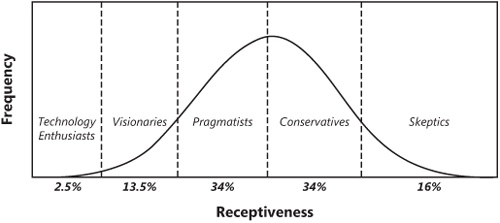When choosing release criteria, keep in mind that different types of customers desire various combinations of time to market, features, quality, and value proposition. Geoffrey Moore divided the potential market for a product into the five customer categories shown in Figure 5-1 (Moore 1991). This analysis was derived from an earlier discussion about the diffusion of innovation by Rogers and Shoemaker (1971). Be sure to know your audience when you’re trying to determine what "done" means for your product.
Technology Enthusiasts are innovators. They get excited about brand-new products they can get into their hands quickly. They’re interested in cool new features and have a high tolerance for defects. They’ll be eager to try out a beta version. However, they only represent a few percent of the potential market for a product. Just because your technology enthusiasts like the product doesn’t mean it’s ready for the mass market yet.
Visionaries are the early adopters. They like new technology and new products. A visionary is willing to be the first one on his block to try out something different. Visionaries are opinion leaders in their organizations. They like to explore fresh ideas but they’re a bit more cautious than the technology enthusiasts. These are the kinds of people who are willing to wrestle with version 1.0 of a new product.
A large fraction of the market fits in the category of Pragmatists, also called the early majority. They adopt change more quickly than average but they don’t have as much tolerance for quality problems as do the technology enthusiasts and the visionaries. If you’re targeting the pragmatists, quality is more important than time to market, and feature set is generally even less of a success driver. Pragmatists don’t want to work through the rough edges on the earliest releases.
About one-third of the potential market consists of the late majority, termed Conservatives. Conservatives don’t adopt new methods and products until they’re already well established in the marketplace. They wait for the product to mature so they can just get their work done with it without having to cope with a lot of problems. Their priorities are reliability first, followed by a useful feature set. They’re willing to wait for the product if necessary, so time to market isn’t terribly important to conservatives.
Skeptics make up the final fraction of the potential market. Also called laggards, they prefer to stick with their old ways of working and are reluctant to accept new ideas or tools. This is the "late kicking-and-screaming" market segment. You’ll never reach them.

